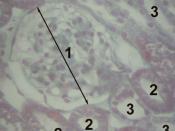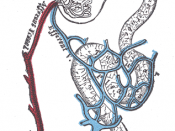-Blood enters each kidney via renal artery and leaves each kidney via renal vein
-Urine exists the kidney through a duct called the ureter and the uruters of both kidneys drain into a common urinary bladder
-Kidney consists of outer renal cortex and inner renal medulla
-Nephron is functional unit of vertebrate kidney
-Consists of single long tubule and ball of capillaries called the glomerulus
-Bowman's capsule surrounds the glomerulus
-Kidney regulates the composition of the blood and produce urine
-Filtration occurs as blood pressure forces water, urea, salts, and other small solutes from the blood in the glomerulus into the Bowman's capsule
-Nonselective
-Filtrate goes into proximal tube, loop of Henle (a hairpin turn with a descending limb and ascending limb) and the distal tubule
-Kidney consists of cortical nephrons and juxtamedullary nephrons (only in mammals and birds)
-Most of filtrate is reabsorbed back into blood; the kidneys take out about 1%
-Proximal and distal tubules are the most common sites of secretion
-Very selective process with both passive and active transport of solutes
-Proximal, distal tubules, and loop of Henle contribute to Reabsorption
-Collecting duct also helps in Reabsorption
-Mammalian's kidney's ability to conserve water is considered an important adaptation
-Antidieretic hormone is important in osmoregulation
-Made in hypothalamus and released when osmolarity in blood rises above certain point
-ADH acts on the distal tubules and collecting ducts by increasing their permeability to water
-Causes more water Reabsorption
-Is turned off through negative feedback
-Juxtaglomerulur apparatus located in the vicinity of the afferent arteriole, which supplies blood to the glomerulus
-When blood pressure or blood volume in the afferent arteriole drops, the enzyme rennin causes chemical reactions that create a peptide called angiotensin II
-Angiotensin II increases blood pressure and blood volume by constricting arterioles and...


